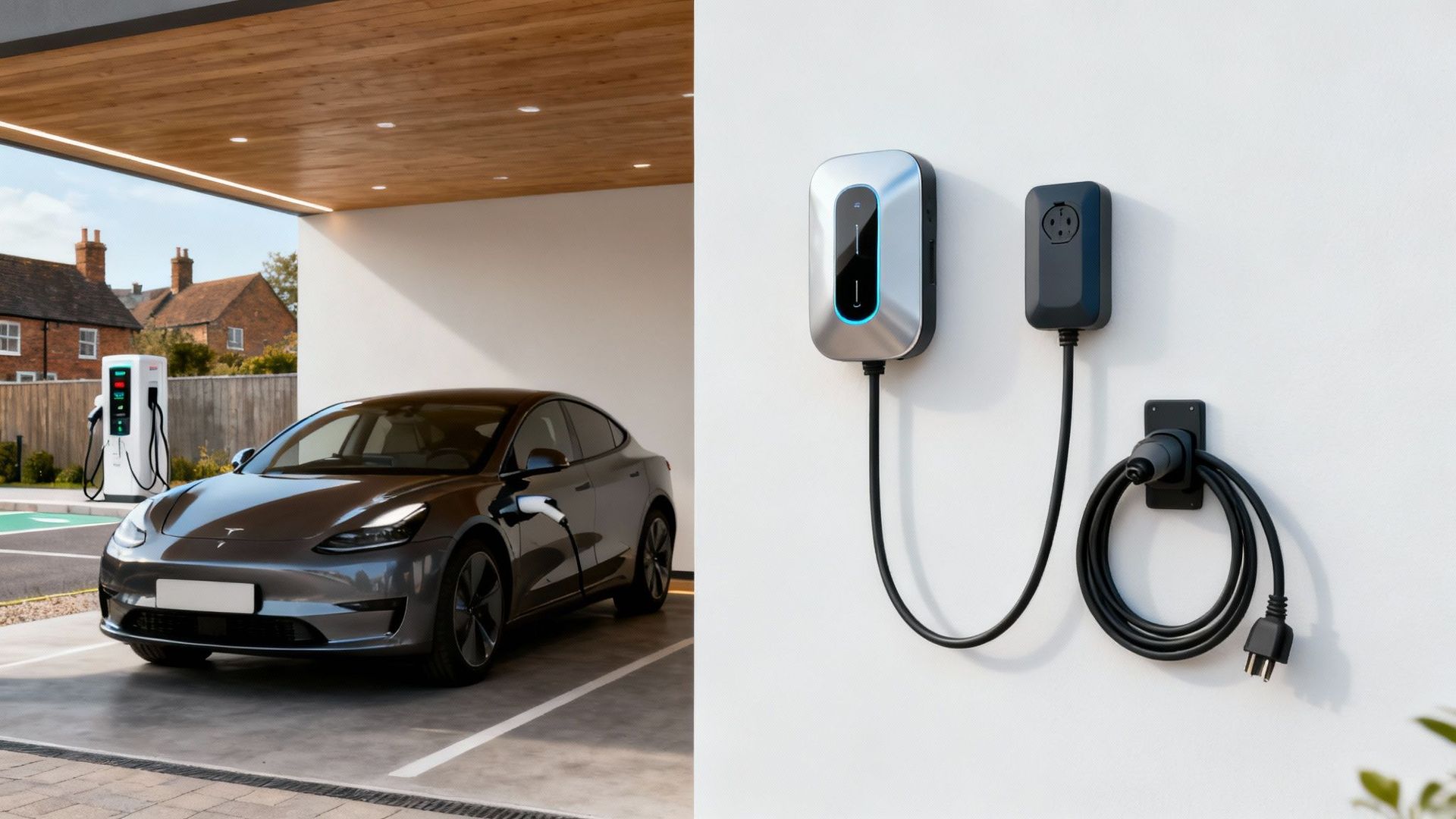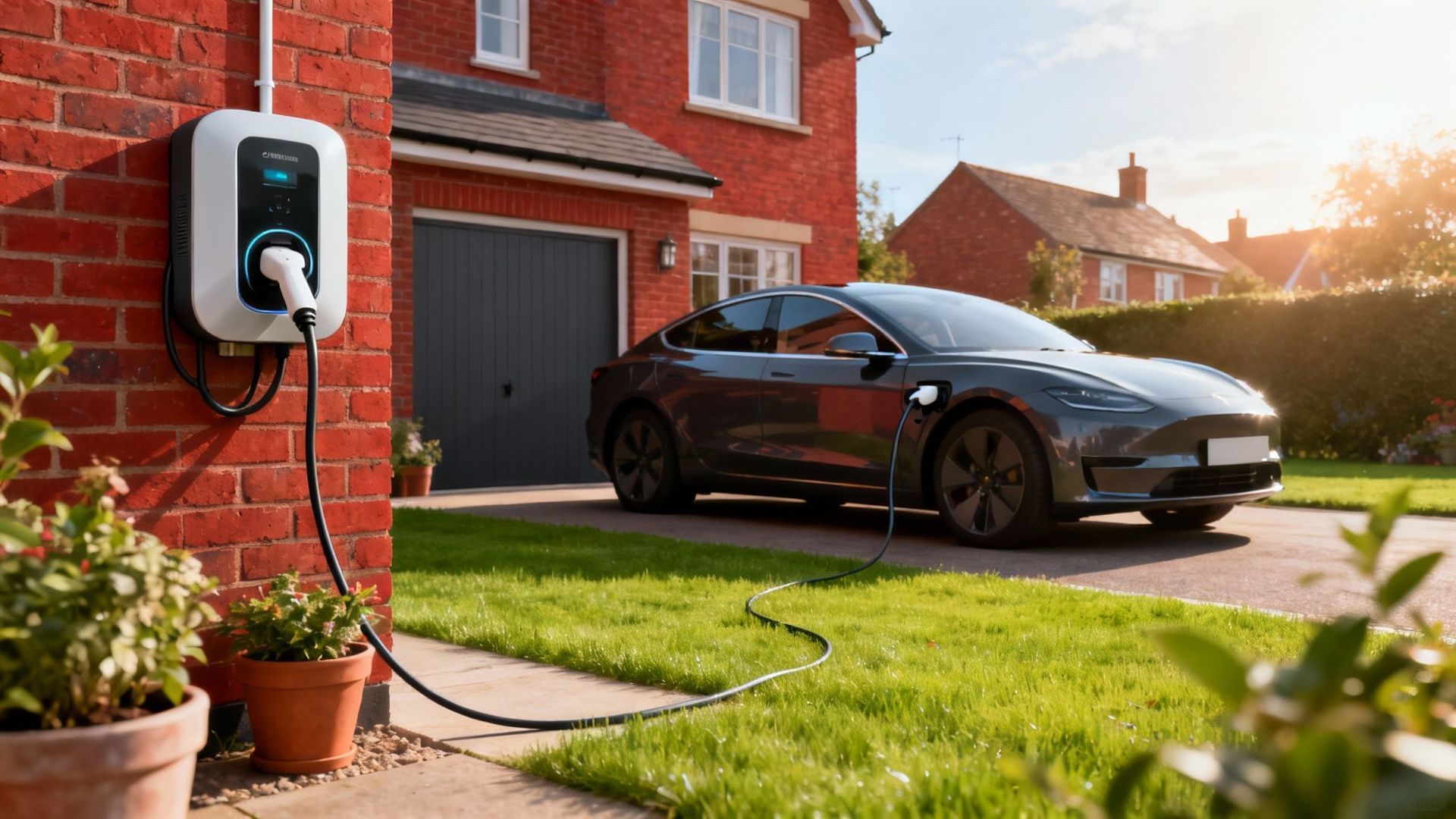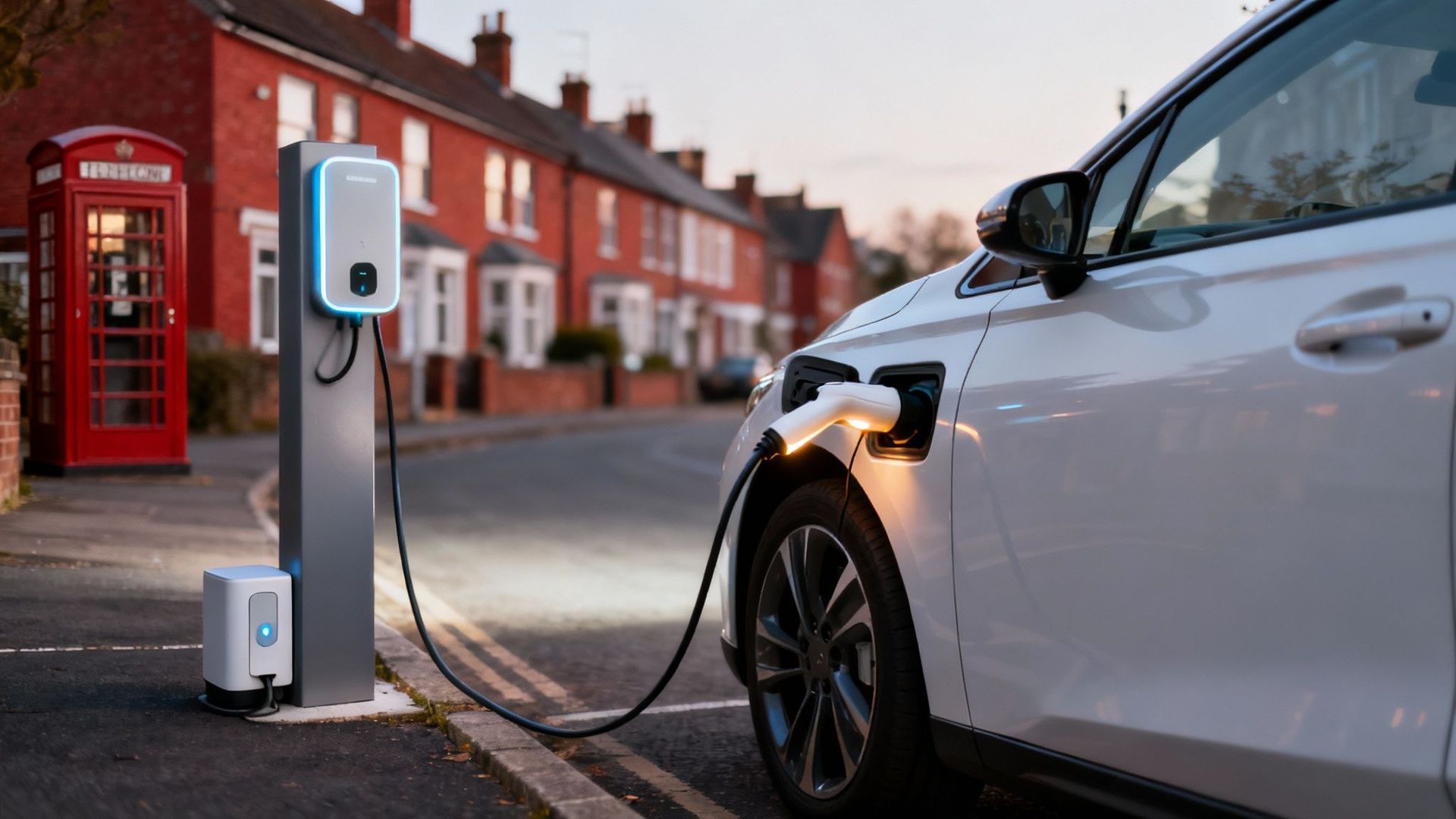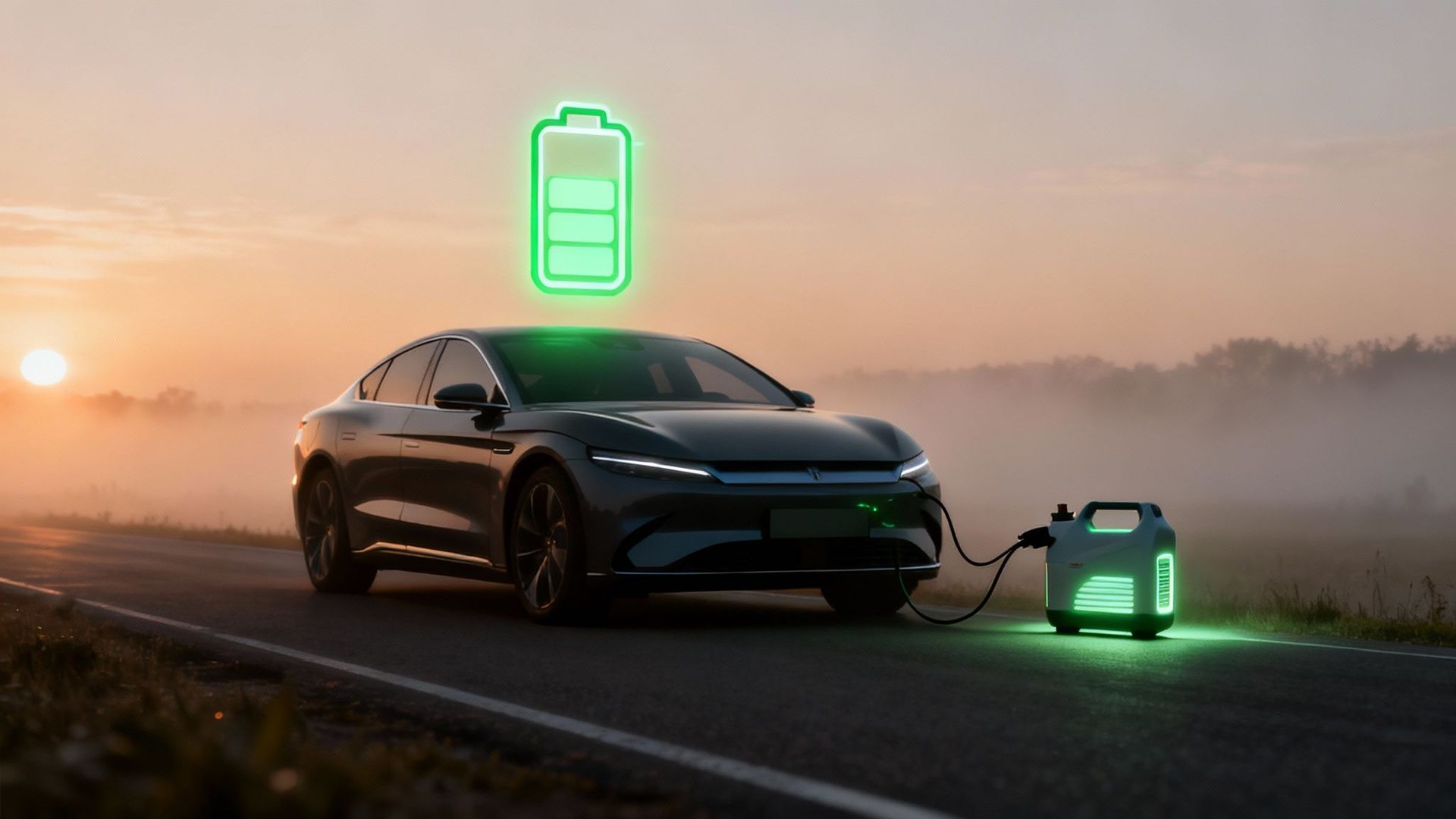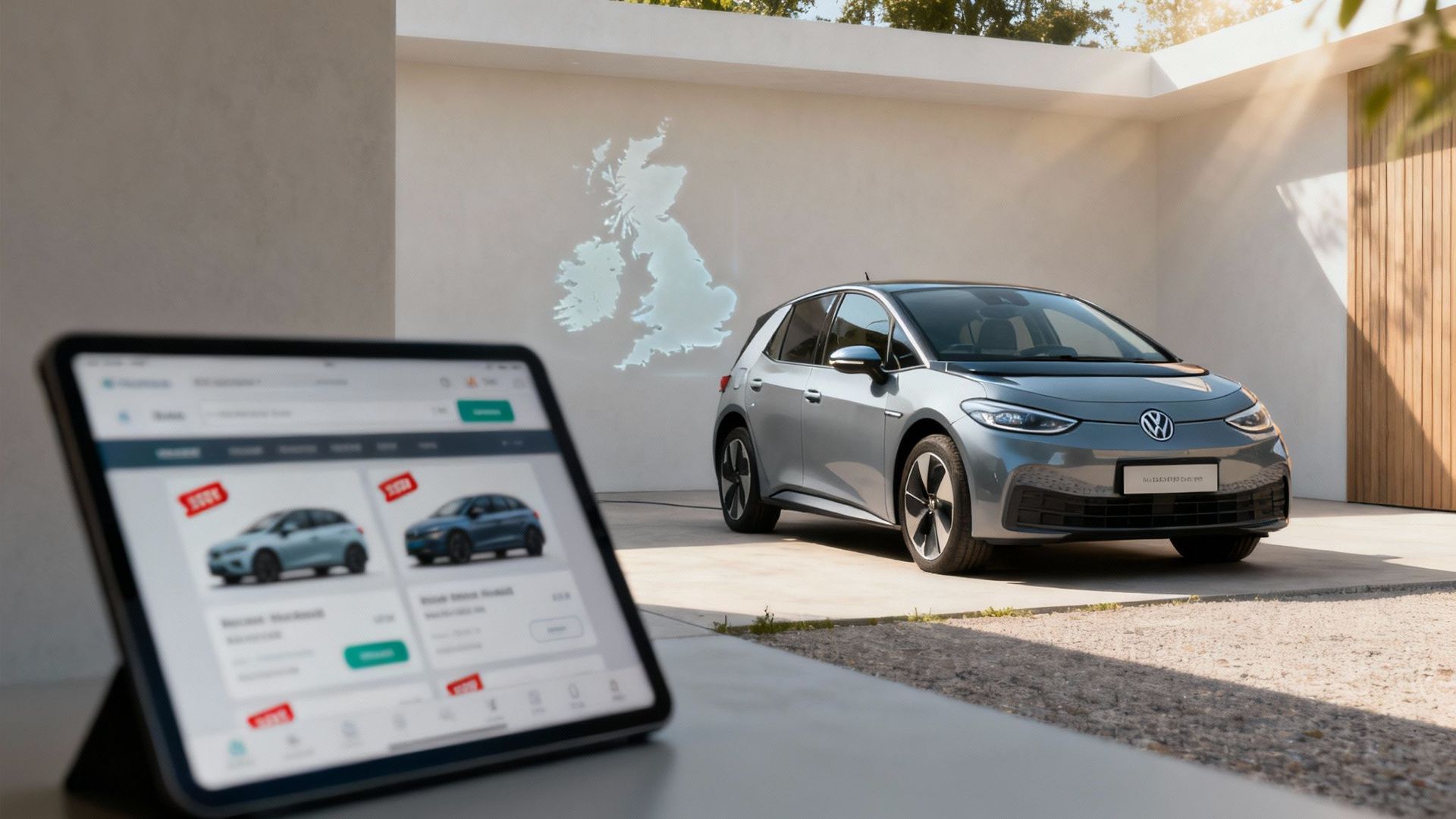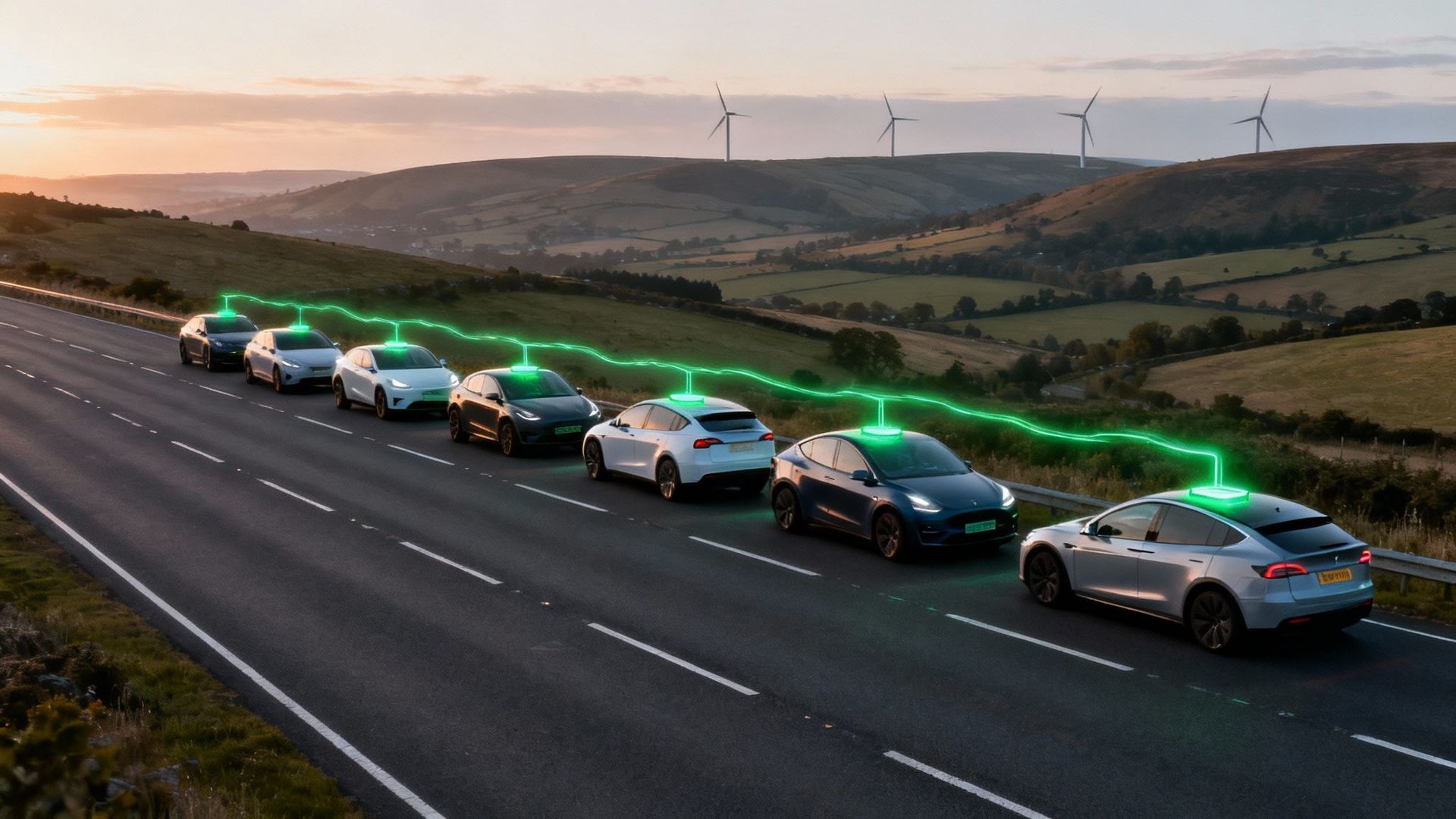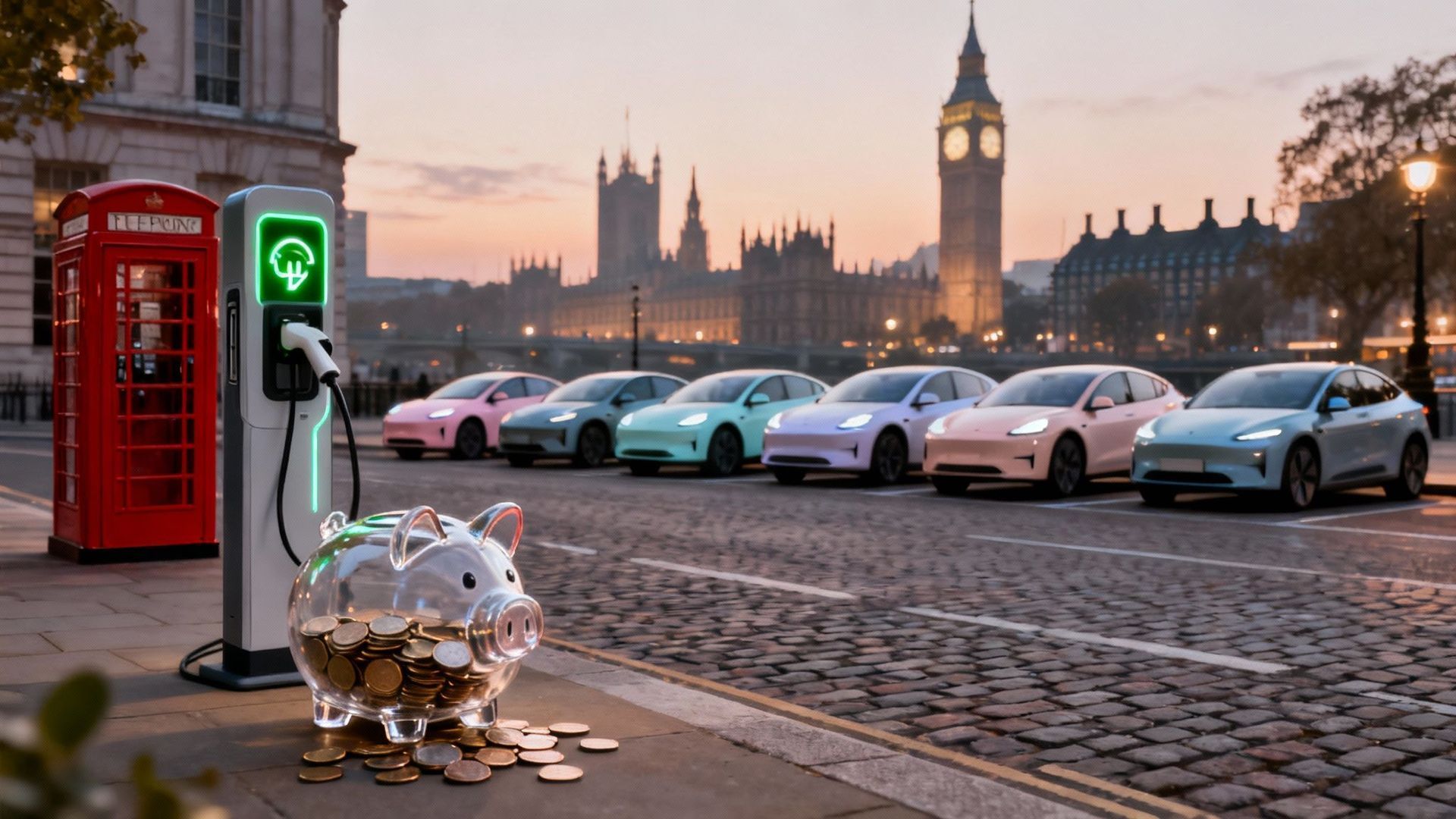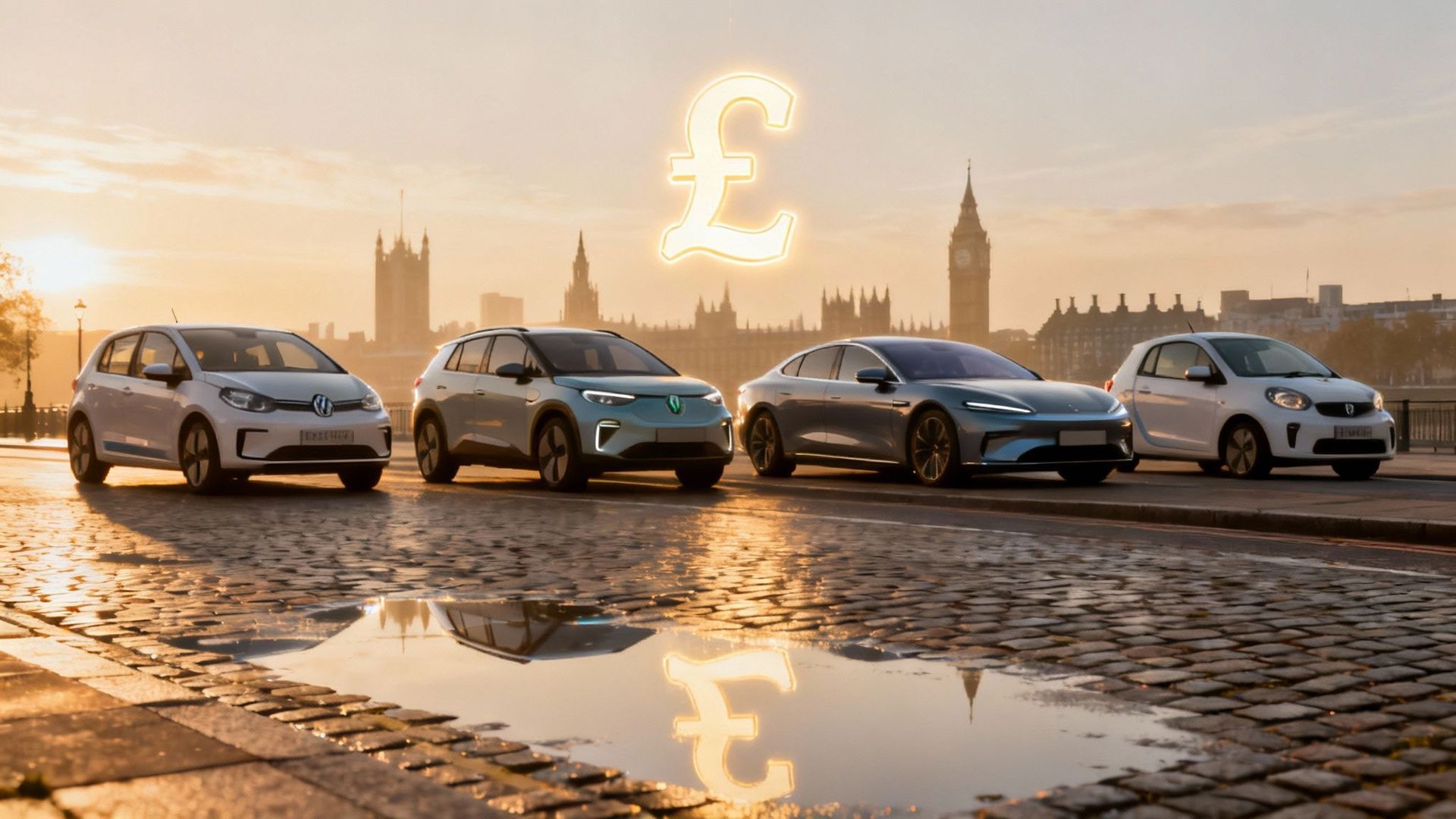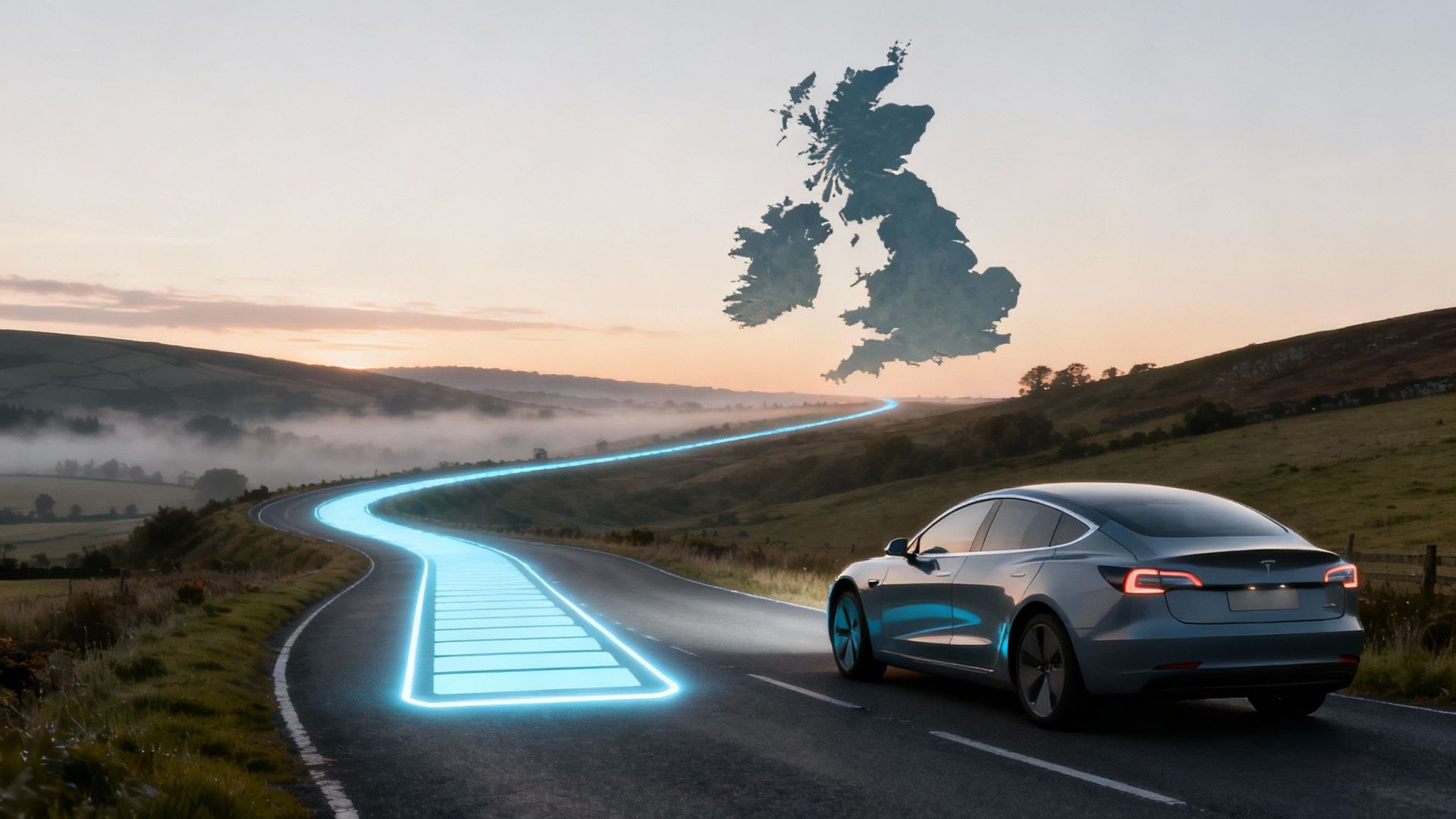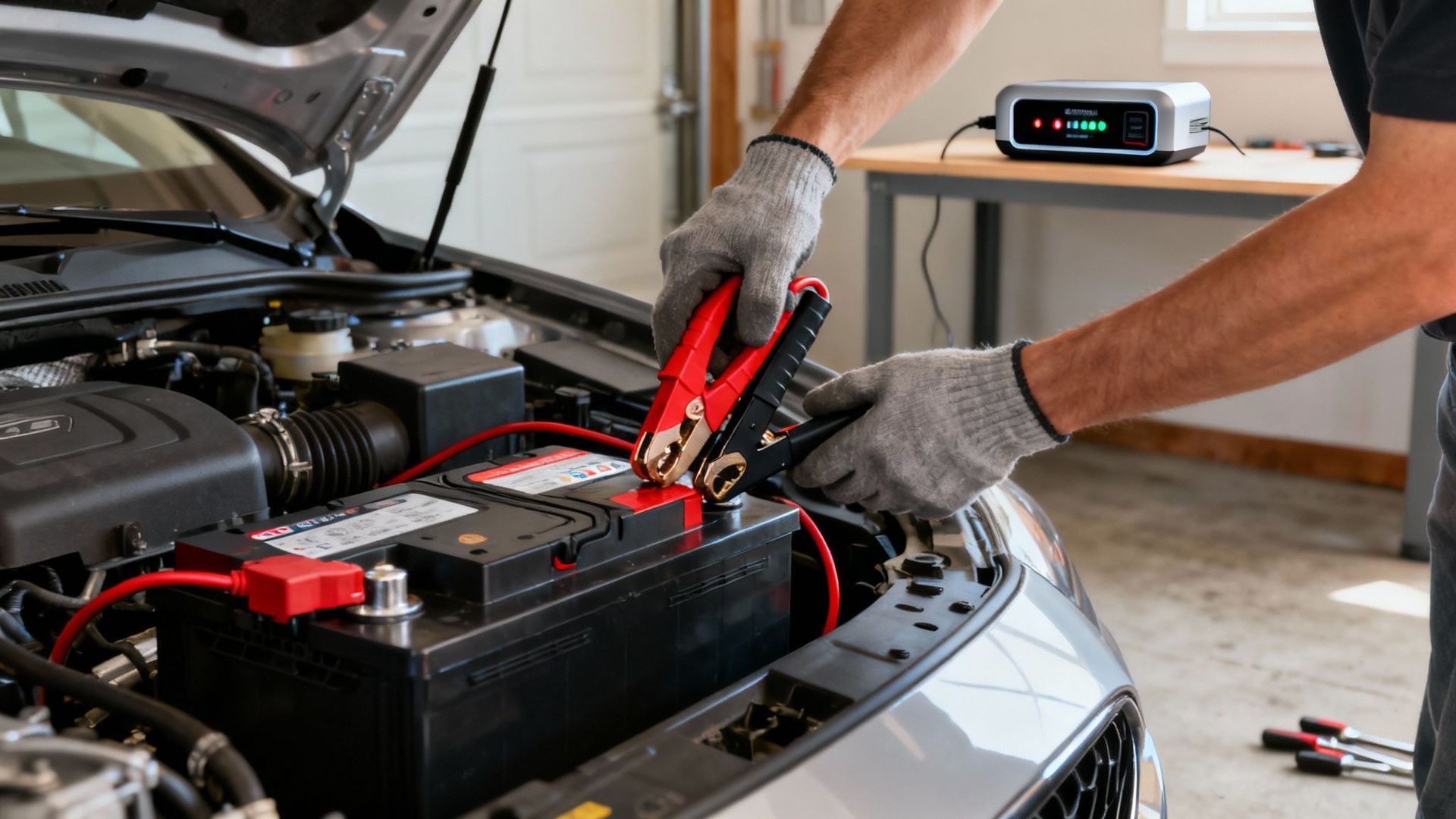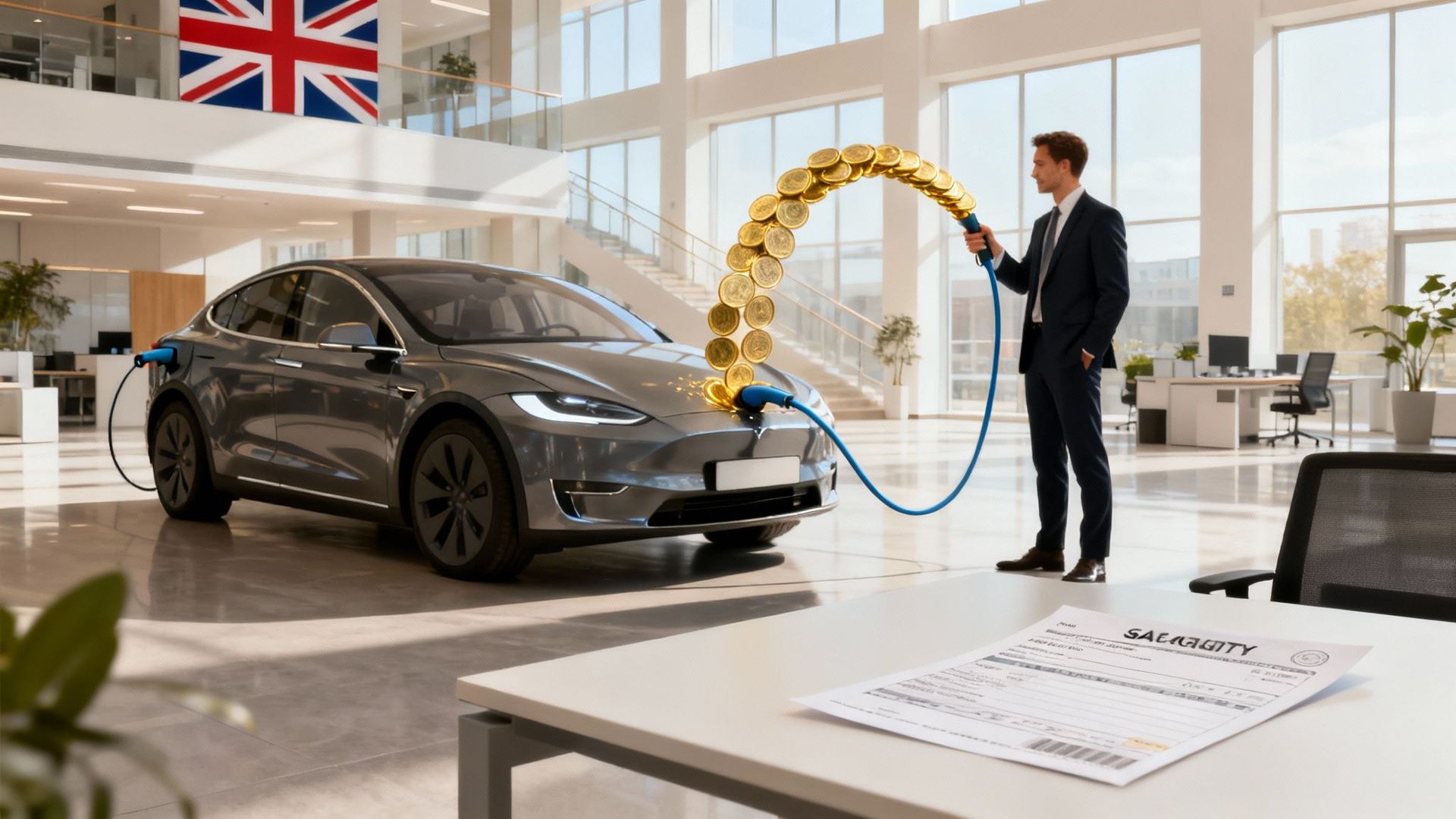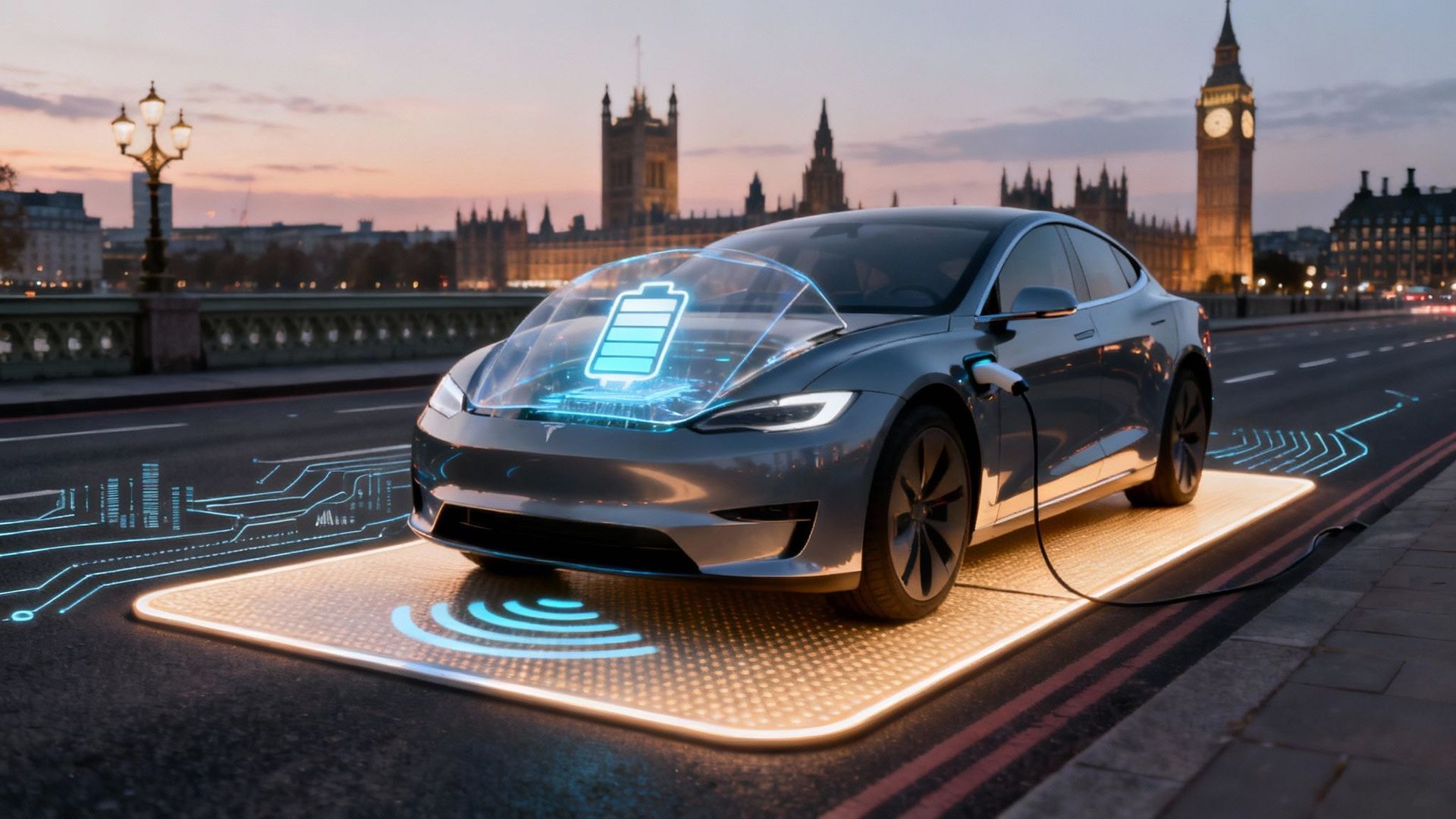A Proper British Survival Guide to Electric Cars
Right, so the thought of swapping your trusty petrol-powered motor for a silent, whirring electric one has crossed your mind. Every electric car review UK drivers stumble across seems to paint a picture of a utopian future—effortless acceleration and waving a smug goodbye to petrol stations. But let's be honest, it’s not quite that simple, is it?
So, You're Thinking About an Electric Car?
It seems everyone is. Maybe your neighbour just got a shiny new EV and won't stop banging on about how much they're saving. You’re definitely not the only one feeling the pull. The move towards electric driving in the UK has been less of a gentle nudge and more of a massive shove, with new registrations for battery electric vehicles (BEVs) going through the roof. Just last September, a record-breaking 72,779 new BEVs joined our roads.
But before you get swept up in the hype, we need to have a proper chat. This isn't the glossy marketing spiel you'll find in a dealership brochure. This is the real-world rundown. We're here to walk you through the good, the bad, and the occasionally infuriating bits of EV ownership—from the thrill of leaving a hot hatch in your dust at the lights to the cold dread of finding the only charger for miles is on the blink.
This infographic really gets to the heart of the dilemma facing many UK drivers today.
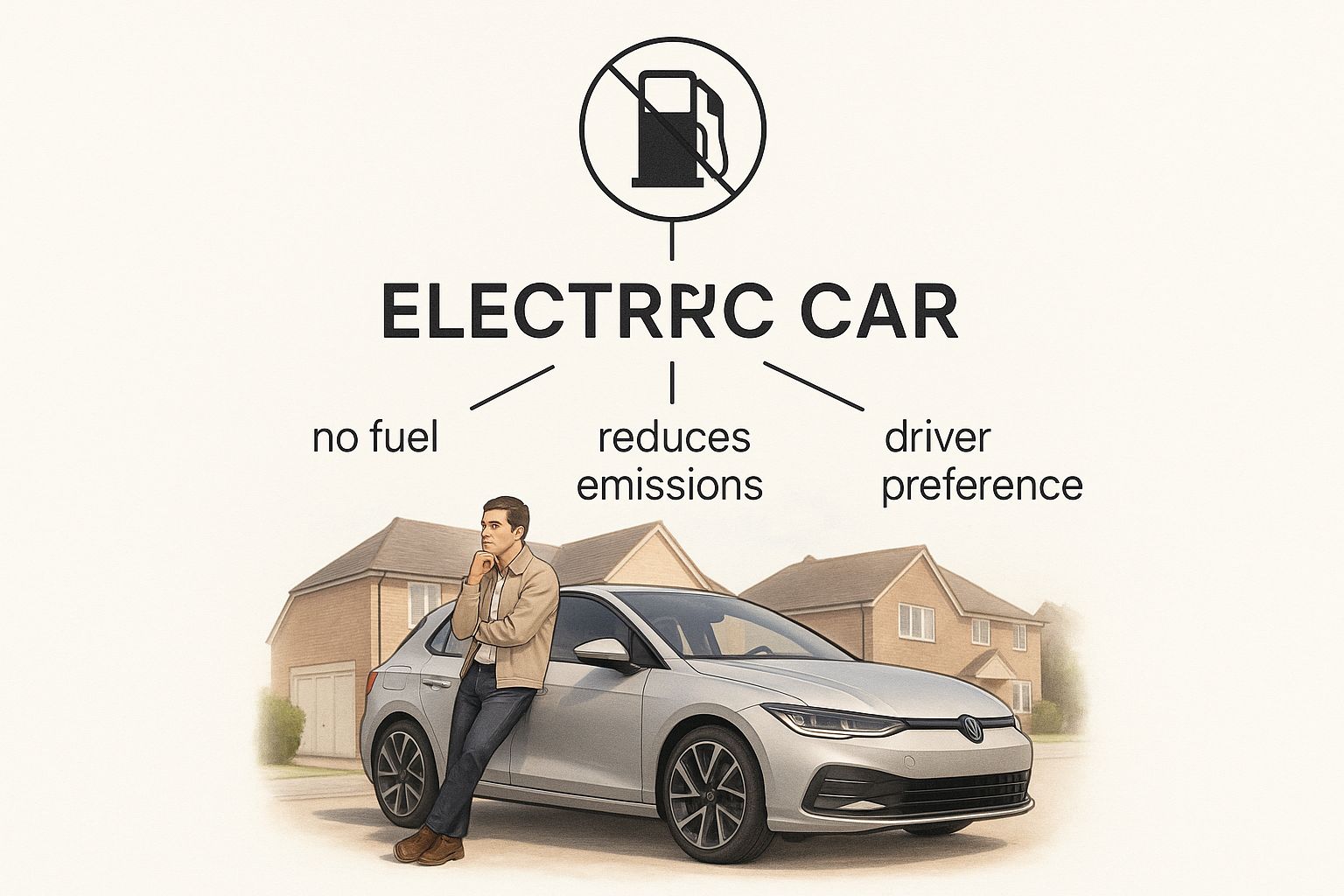
It perfectly captures that pivotal moment: leaving the familiar, and increasingly eye-watering, world of fossil fuels for a cleaner, quieter, but very different way of driving.
The Real State of Play in Britain
Let’s be brutally honest about what owning an EV in the UK is actually like. It’s a fascinating mix of futuristic convenience and head-scratching moments. One morning you’ll feel like an absolute genius, having ‘filled up’ your car overnight for a few quid. The next, you might find yourself in a queue at a motorway service station, wondering if the person ahead of you has ever heard of charging etiquette.
The reasons for making the switch are incredibly strong, and it's about more than just doing your bit for the planet. The core appeal boils down to a few key things:
- Instant Torque: That immediate, silent shove in your back when you touch the accelerator is seriously addictive.
- Lower Running Costs: Charging up at home, particularly with an off-peak electricity tariff, is a fraction of the cost of a tank of petrol or diesel.
- A Quieter Life: The near-total silence from the motor creates an incredibly calm and refined driving experience.
But the decision to go electric is about so much more than just the car. It’s about your life and how a car fits into it. Can you install a charger at home? Is your daily drive a quick ten-mile commute or a 300-mile slog up the M6? These are the questions that truly matter, and this guide is here to give you the straight answers you need.
Getting Your Head Around the Jargon
Right, let's have a word about the secret language car manufacturers invented to make buying an electric car feel like you’re trying to decipher ancient hieroglyphs. It’s a baffling alphabet soup of acronyms and technical terms seemingly designed to make you feel a bit thick.
Fear not. Think of this as your personal, no-nonsense translator, turning the gobbledygook into plain English.
Battery Size vs. Charging Speed
First up, the big one: kWh , or kilowatt-hour. Forget the complicated science lesson; just think of it as the size of your car's fuel tank. A bigger number, like the 100kWh battery in a Polestar 4 , simply means a bigger 'tank' and, in theory, more miles between stops. It’s the single most important figure for judging how far you can get on a single charge.
This naturally leads us to kW , or kilowatt. If kWh is the size of the tank, kW is the speed of the fuel pump. A 7kW home charger is like a slow, steady trickle-feed overnight. In contrast, a mighty 150kW rapid charger on the M6 will sling electrons into your battery with the ferocity of a fire hose. The higher the kW, the less time you'll spend loitering in a service station car park.
Knowing Your Plugs and Power
Now, let’s talk about the actual plugs, because of course, there isn't just one type. For your day-to-day charging in the UK and Europe, you'll mostly be using a Type 2 connector. This is the standard for home wallboxes and the slower public chargers you find at the supermarket. It’s the reliable workhorse of EV charging.
But when you're in a real hurry, you'll need the big guns. This is where CCS (Combined Charging System) comes in. It’s essentially a Type 2 plug with two extra big pins underneath for high-speed DC (Direct Current) charging. Think of it as the super-unleaded pump of the electric world—it’s how you get those blistering 150kW+ speeds.
The key takeaway here is simple: AC (Alternating Current) charging is for home and destination top-ups (slow and steady), while DC (Direct Current) charging is for rapid top-ups on long journeys (fast and furious). Your car converts the AC from the grid to DC for the battery, but a DC charger bypasses that step, pumping power straight in.
The Different Flavours of Electric
Not all electric cars are created equal, and the acronyms tell you what you’re getting. Here's a quick breakdown of the main types you'll see in any UK electric car review:
- BEV (Battery Electric Vehicle): This is the full monty. A BEV runs purely on electricity from its battery. No engine, no exhaust, no petrol stations. Think Tesla Model Y or an MG4.
- PHEV (Plug-in Hybrid Electric Vehicle): The cautious person’s EV. A PHEV has both a battery and a petrol engine. You can do shorter trips (usually 20-40 miles) on pure electric power, but you have the engine as a backup for longer journeys, removing any range anxiety.
- HEV (Hybrid Electric Vehicle): Often called a ‘self-charging’ hybrid, which is a clever bit of marketing spin. You can’t plug these in. A small battery is charged by the engine and through regenerative braking —where the car recaptures energy when you slow down—to assist the petrol motor and improve fuel economy.
And that brings us to the final piece of jargon: regenerative braking. It’s a brilliant system where lifting your foot off the accelerator or pressing the brake pedal makes the electric motor run in reverse. This not only slows the car down but also sends a bit of electricity back into the battery.
In heavy traffic, it means you can often drive using just one pedal, barely touching the brakes and recouping energy as you go. It’s one of the genuinely clever bits of EV tech that makes perfect sense once you experience it.
To pull all this together, here’s a quick-glance table to keep you right.
The EV Jargon Buster for UK Drivers
| Term or Acronym | What It Means in Plain English | Why It Actually Matters to You |
|---|---|---|
| kWh (Kilowatt-hour) | The size of your car's "fuel tank." | A bigger kWh number means a bigger battery, which usually translates to a longer range between charges. |
| kW (Kilowatt) | The speed of the "fuel pump." | Higher kW means faster charging. A 7kW home charger is slow; a 150kW public charger is very fast. |
| AC Charging | "Slow" charging from the mains, like at home. | This is what you'll use overnight. It's cheaper and better for long-term battery health. |
| DC Charging | "Fast" or "Rapid" charging at public stations. | This is for quick top-ups on long journeys. Essential for motorway trips. |
| Type 2 Connector | The standard plug for most AC charging in the UK. | This is the plug you'll use most often at home, work, and supermarkets. |
| CCS Connector | The standard plug for DC rapid charging in the UK. | This is the one you need to use the fast motorway chargers. It's a Type 2 with two extra pins. |
| BEV | A 100% fully electric car. No petrol engine. | This is what most people mean by an "EV." Zero tailpipe emissions, no road tax. |
| PHEV | A car with both a petrol engine and a battery you can plug in. | Offers a bit of electric-only driving (e.g., the school run) with the backup of a petrol engine. |
| Regenerative Braking | The car recharges the battery a little when you slow down. | It boosts your efficiency and means you use the actual brake pedal far less, especially in town. |
Hopefully, that clears things up. Once you've got these basics down, you'll find that all the specs and reviews start to make a lot more sense.
The Unvarnished Truth About Charging in the UK
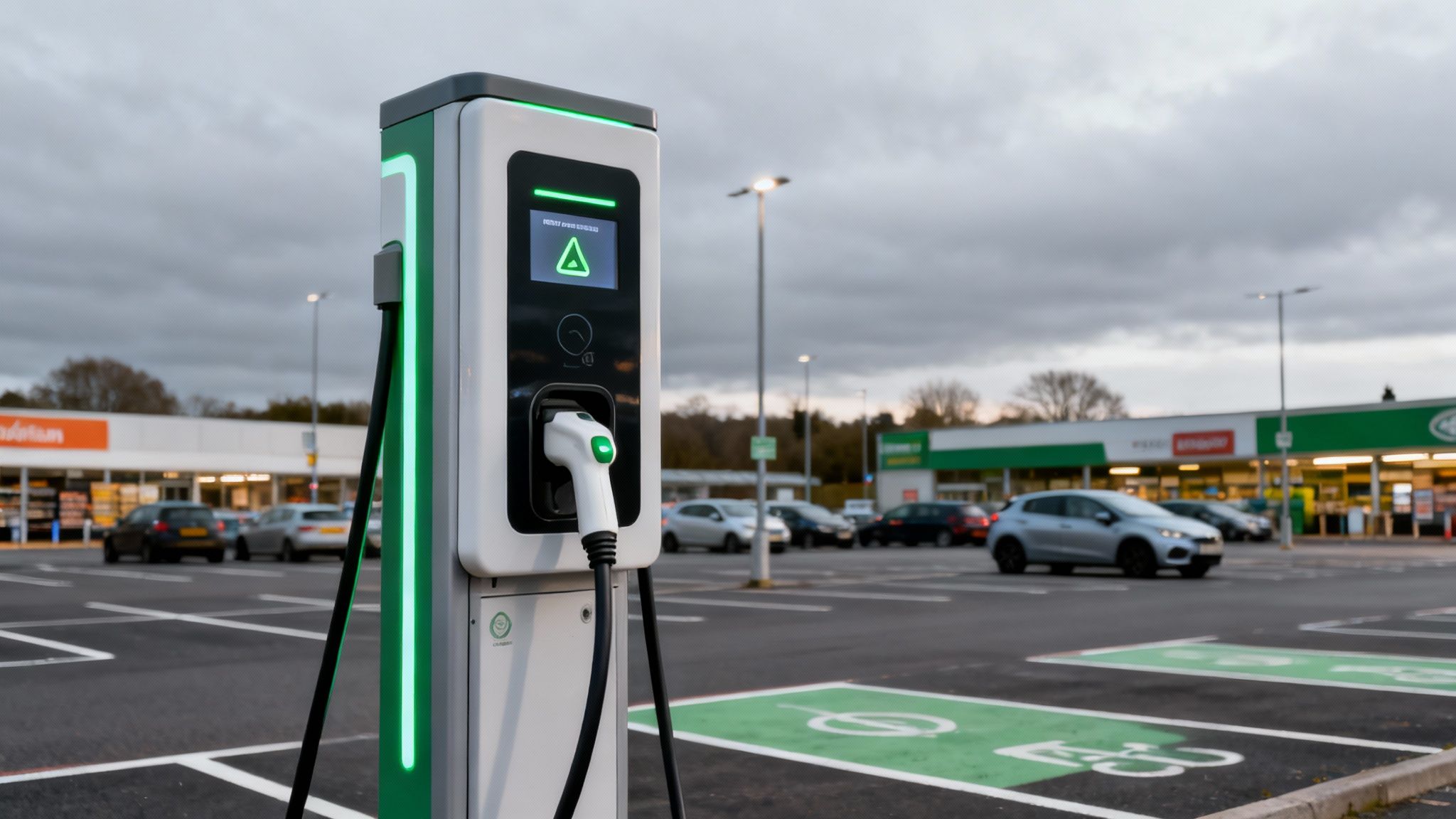
Right, let’s get straight to the elephant in the room: charging. The brochures show stylish people effortlessly plugging in their silent cars on a perfect, sunny day. The reality, as you might expect in the UK, can be a bit more... variable. Think damp, occasionally frustrating, and sometimes requiring a flask of tea and a good dose of patience.
This is your brutally honest guide to keeping an electric car topped up in Blighty. We’re skipping the marketing spin and diving headfirst into what it’s really like. The simple truth is that while EV ownership is exploding, the public infrastructure is still playing catch-up.
Just look at the numbers. The Society of Motor Manufacturers and Traders (SMMT) reported that September saw a staggering 72,779 new battery electric vehicles hit the road, a 29.1% leap from the year before. That surge meant electrified vehicles claimed over half of the new car market that month—a clear signal that drivers are ready for the switch. You can dig into all the official EV registration data over on the SMMT website.
The Home Charging Haven
Let's begin with the absolute best-case scenario: charging at home. If you have a driveway or garage, this is the single biggest game-changer. Seriously. Installing a dedicated home charger, often called a ‘wallbox’, makes owning an EV almost laughably convenient.
Picture this: you wake up every morning with a 'full tank' that cost you just a few quid, all thanks to a cheap overnight electricity tariff. It’s like having your own private petrol station, but without the questionable sausage rolls and the lingering smell of diesel. This is the smug, utopian future we were promised, and for the most part, it absolutely delivers.
The tricky part? Navigating the world of installers and grants can feel like solving a Rubik's Cube in the dark. The rules keep shifting, government grants have dwindled, and finding a reliable sparky who won’t charge the earth can be a quest in itself.
Welcome to the Public Charging Lottery
Step away from your driveway, however, and you’re entering the Wild West of public charging. It’s a chaotic jumble of competing networks, requiring you to have a dozen different apps on your phone. This is where 'charger anxiety' becomes a very real thing—that sinking feeling you get when you arrive somewhere, only to find the one available plug is out of order.
The UK's public charging network is a classic postcode lottery. In some city centres and along major motorways, you'll find gleaming banks of ultra-rapid chargers that can blast your battery to 80% in the time it takes to grab a coffee. But in other, more forgotten corners of the country, you’ll be lucky to find a single, sad-looking 7kW post tucked away behind the bins in a supermarket car park.
This inconsistency is, without a doubt, the biggest source of frustration for many EV drivers today. For a deeper dive into the current state of play, check out our guide on the EV charging landscape in the UK.
A Lesson in Charger Etiquette
Or, perhaps more accurately, the stunning lack of it. Public charging bays have become the new frontier for truly baffling human behaviour. Prepare to meet:
- The Full-Battery Blocker: Someone who leaves their fully charged car plugged in for hours, treating the bay like their own personal VIP parking spot.
- The Petrol Trespasser: The driver of a fossil-fuelled car who has, for reasons unknown, decided the EV charging bay is the perfect place to abandon their clattering diesel SUV.
- The Cable Curmudgeon: The person who parks so badly their charging cable is stretched taut across the bay, making it impossible for anyone else to get near the second plug.
Mastering the art of the polite-but-firm stare is an essential skill for any UK EV driver. The infrastructure is one challenge; navigating the people using it is a whole other level.
How Much This Silent Motoring Actually Costs
So, you’ve been tempted by that instant, silent acceleration and the idea of waving a smug farewell to the local petrol station. Before you get too carried away, let's talk brass tacks. That hefty figure on the windscreen is just the opening act in the financial story of owning an electric car.
The real cost is a mix of things: electricity tariffs, surprisingly high insurance premiums, the blissful lack of maintenance, and that ever-present question of depreciation. It’s time to get the calculator out and run the numbers that the salesperson might have conveniently glossed over.
The Upfront Cost vs The Long Game
Let’s not beat around the bush: an EV will almost certainly cost you more to buy than a similar petrol car. That initial sting in the showroom is the biggest hurdle for most people. But thinking only about the purchase price is like judging a film by its opening scene—you miss the whole plot.
The real financial story unfolds over years of ownership. While your petrol-driving mates are wincing at the price per litre on the forecourt, you could be ‘fuelling’ your car for a tiny fraction of that. If you can charge at home on a cheap overnight electricity tariff, your per-mile cost plummets.
For many, the calculation is simple: a higher initial outlay for significantly lower running costs. The game is to figure out if you'll own the car long enough for those savings to overtake the bigger price tag.
Unpacking the Real Running Costs
Forget everything you know about running a car. The cost breakdown for an EV is a completely different beast. There are some brilliant savings to be had, but also a few hidden expenses you need to be aware of.
Let’s break down the main players in the total cost of ownership:
- Fuelling (Charging): This is where you score the biggest win. Charging at home on an off-peak tariff can cost as little as 7.5p per kWh . For a typical EV, that works out to about 2-3p per mile . Now compare that to a petrol car averaging 40mpg, which costs around 18p per mile . The difference is enormous.
- Servicing and Maintenance: With no oil changes, spark plugs, or exhaust systems to worry about, EV servicing is a simpler, and usually cheaper, affair. Most main dealer services are just a series of checks and balances, costing a lot less than their combustion-engine equivalents.
- Vehicle Excise Duty (VED): Right now, pure electric vehicles pay £0 in road tax . It's a tidy annual saving, but be warned—the government plans to change this from 2025, so it won't last forever.
- Insurance: Here’s a potential sting in the tail. Insurers often quote higher premiums for EVs. They point to the specialist repair costs for batteries and the often rapid acceleration as reasons. It really pays to shop around and compare quotes.
The Company Car Game Changer
Right, if you're a company car driver, stop what you’re doing and listen up. The tax advantages of running an electric car are, frankly, monumental. The Benefit-in-Kind (BiK) tax rate for electric cars is currently frozen at a ridiculously low 2% .
A comparable petrol or diesel car could easily see you paying BiK tax at rates of 25-37% . Over a year, this difference can save a higher-rate taxpayer thousands upon thousands of pounds. For many people in this position, this tax break alone is enough to make the switch a complete financial no-brainer.
For a more granular comparison of the day-to-day expenses, you can explore our detailed guide on the real cost of owning an EV compared to petrol cars, which breaks down every last penny.
The financial case for an EV isn't just about feeling good; it’s about carefully weighing up these new-world costs. From the price of a home charger installation to the wildly fluctuating cost of public rapid chargers, the maths has changed entirely.
Our Top EV Picks for Every Type of Brit

Right, let's get down to the business of actually picking a car. Forget the dry, spec-obsessed reviews that read like an engineering textbook. We’ve put together a list for real people living real lives here in the UK.
We’re carving up the market and giving you our top picks based on what you actually do with your car, not just its 0-60 time. We'll praise the genuinely clever features and have a bit of a laugh at the utterly daft design choices. This is where we tell you which cars are brilliant and which are just a pretty face with no substance.
For The Urban Warrior Squeezing into Tight Spots
If your daily drive involves navigating narrow city streets and fighting for microscopic parking spaces, you need something small, nimble, and cheap to run. For that, the MG4 EV is the undisputed champion. It's a proper bargain, offering a decent range and a surprisingly fun driving experience without demanding a second mortgage.
Sure, the interior has a few scratchy plastics, and the infotainment screen can occasionally decide to have a sulk. But for the price, it’s an absolute steal. It’s the perfect tool for the urban jungle: compact enough to thread through traffic but with enough poke to surprise a few hot hatches at the lights.
For The Family Hauler Doing The School Run
You've got kids, car seats, and a boot that needs to swallow a mountain of school bags, sports kits, and the occasional flat-pack furniture disaster. You need practicality, space, and a healthy dose of safety features. Enter the Kia EV6 .
It looks like something from a sci-fi film, which the kids will love, but inside it's a cavern of sensible, well-thought-out space. The flat floor means no more arguments about who has to sit on the hump in the middle, and the boot is genuinely massive. It also has a stonkingly good real-world range, meaning you can handle a week of school runs and a weekend trip to the grandparents without breaking a sweat.
For The Motorway Muncher Racking Up The Miles
If your job involves spending more time on the M1 than at your own desk, your priorities are simple: long-range comfort and brutally efficient rapid charging. This is where the Polestar 4 muscles its way to the front of the queue.
It’s a magnificent long-distance cruiser—quiet, comfortable, and absolutely planted on the road. The dual-motor version has a huge 100kWh battery that delivers a genuine, year-round 300-mile range . Perhaps its most talked-about feature is the complete lack of a rear window, replaced by a high-definition camera. It sounds crackers, I know, but it works brilliantly, giving you a crystal-clear, wide-angle view behind you.
It feels premium, drives beautifully, and makes a 200-mile slog feel like a trip to the shops. To see what else is on the horizon, have a look at our roundup of the latest EVs for 2025.
For The Driver Who Wants Something Different
Tired of seeing the same handful of models in every car park? The electric revolution has brought a wave of new brands looking to shake things up, and some of them are seriously impressive. Chinese manufacturers, in particular, are making huge waves right now.
The UK has rapidly become a key battleground for these new entrants. In fact, Britain is now the top European market for BYD, one of the world's biggest EV makers, which saw an astonishing 880% sales surge here. This explosive growth shows just how keen UK drivers are to find reliable and affordable electric alternatives.
One of the standout challengers is the Xpeng G6 . It’s a slick, sophisticated machine that offers luxury-car levels of quietness and comfort for a price that undercuts many of its established rivals. The build quality is superb, the tech is seamless, and it proves that the legacy carmakers are facing a monumental challenge from these ambitious newcomers. Keep an eye on them; they’re producing genuinely brilliant cars that are impossible to ignore.
Right then, after navigating the alphabet soup of EV acronyms, the wild west of public charging networks, and those eye-watering price tags, we’ve arrived at the big one. The thirty-thousand-quid question: should you actually buy an electric car?
If you’re after a straight ‘yes’ or ‘no’, I’m afraid it’s not that simple. The honest answer is a thoroughly British and slightly frustrating, "Well, it depends." An electric car isn't a one-size-fits-all magic bullet. Whether it’s right for you comes down entirely to your lifestyle, your budget, and frankly, your patience for when technology decides to have a bit of a strop.
Think of it as a set of scales. On one side, you have the undeniable perks: that instant, silent shove of acceleration that never gets old, the quiet satisfaction of waking up to a 'full tank' for less than a tenner, and a cabin so quiet you can hear yourself think. These are the moments that make owning an EV feel like you’re living in the future.
The Final Verdict Is Yours
On the other side of the scales, you’ve got the drawbacks, and they’re not to be ignored. The initial purchase price can still bring a tear to your eye, and relying on public charging can feel like a lottery. For every shiny new bank of ultra-rapid chargers, there’s a lone, broken unit in a rain-lashed car park waiting to crush your spirit. That isn’t fearmongering; it’s just the current reality any honest electric car review UK drivers need to know about.
In the end, it all boils down to a few critical questions you need to ask yourself:
- Can you charge at home? If the answer is yes, the scales tip massively in favour of going electric. It’s the cheapest, most convenient way to run an EV and the single biggest factor in a happy ownership experience.
- What does your typical journey look like? If you’re mostly zipping around town or have a predictable daily commute, an EV will likely fit into your life like a glove. If you’re a sales rep covering hundreds of motorway miles a day, you’ll need a car with a hefty battery and the patience of a saint.
- Are you ready for a new driving mindset? Owning an EV demands a bit of forward planning. You start thinking about journeys differently, using apps to scout out chargers and building in stops. It’s a change in habit as much as a change in car.
The UK's shift to electric is well and truly on. Last year alone, a record 381,970 new electric cars hit the roads, making up a significant 19.6% of all new car sales. Top-sellers like the Tesla Model Y show that British drivers are embracing the change. You can find more details on these surging sales figures and what they mean for the market.
Whether you join them comes down to your answers. If you’ve got a driveway and your mileage is mostly local, the case for an EV is compelling. If you live in a top-floor flat with no dedicated parking and drive to Inverness every other week, you might want to wait a little longer. The electric revolution is happening, but only you can decide if it's the right time for you to sign up.
Your Electric Car Questions Answered
We’ve waded through a lot of the jargon and thorny issues, from decoding EV specs to the realities of public charging. Still, a few key questions always seem to surface. Let's tackle some of the most common queries head-on.
How Long Do Electric Car Batteries Actually Last in the UK?
This is the big one, isn't it? The nagging fear that your battery will suddenly pack it in the moment its warranty expires. The good news is, you can probably relax.
Most manufacturers back their batteries with a solid warranty, typically for eight years or 100,000 miles . They usually guarantee that the battery will retain at least 70% of its original capacity during that time. In reality, modern EV batteries are proving to be impressively durable. The UK's temperate climate helps too, as it avoids the extreme heat and cold that can really punish a battery over time.
Catastrophic, sudden battery failure is incredibly rare. What you're far more likely to experience is a slow, gentle decline in range over many, many years – much like your smartphone's battery, just on a much larger and longer scale.
Is the UK Public Charging Network Really That Bad?
Honestly, it depends where you are. Along major motorways and in big cities, the rapid charging infrastructure is growing fast and getting more reliable by the day. It's now perfectly feasible to drive the length of the country without much fuss.
The real frustration comes from the inconsistency. You might find a state-of-the-art charging hub at one service station, but then a single, broken charger in a dimly lit rural car park an hour later. This has given rise to a new phenomenon: 'charger anxiety' has replaced 'range anxiety'. It’s improving, but there’s still work to do.
Will an Electric Car Actually Save Me Money?
For the vast majority of drivers, the answer is a firm 'yes' – but there's a huge caveat. You really need to be able to charge at home. Plugging in overnight and taking advantage of a cheap electricity tariff means your running costs will be a tiny fraction of what you'd pay for petrol or diesel. Servicing is generally cheaper and less frequent, too.
If you have to rely exclusively on pricey public rapid chargers for all your top-ups, those potential savings can evaporate pretty quickly. It's also worth getting an insurance quote, as premiums can sometimes be higher. You need to run the numbers for your own circumstances, but for the average UK driver with off-street parking, the long-term financial benefits are hard to ignore.
Ready to dive deeper into the world of EVs? At VoltsMonster , we cut through the noise with honest reviews, practical advice, and a healthy dose of humour. Find your next electric car obsession by visiting us at https://www.voltsmonster.com.

